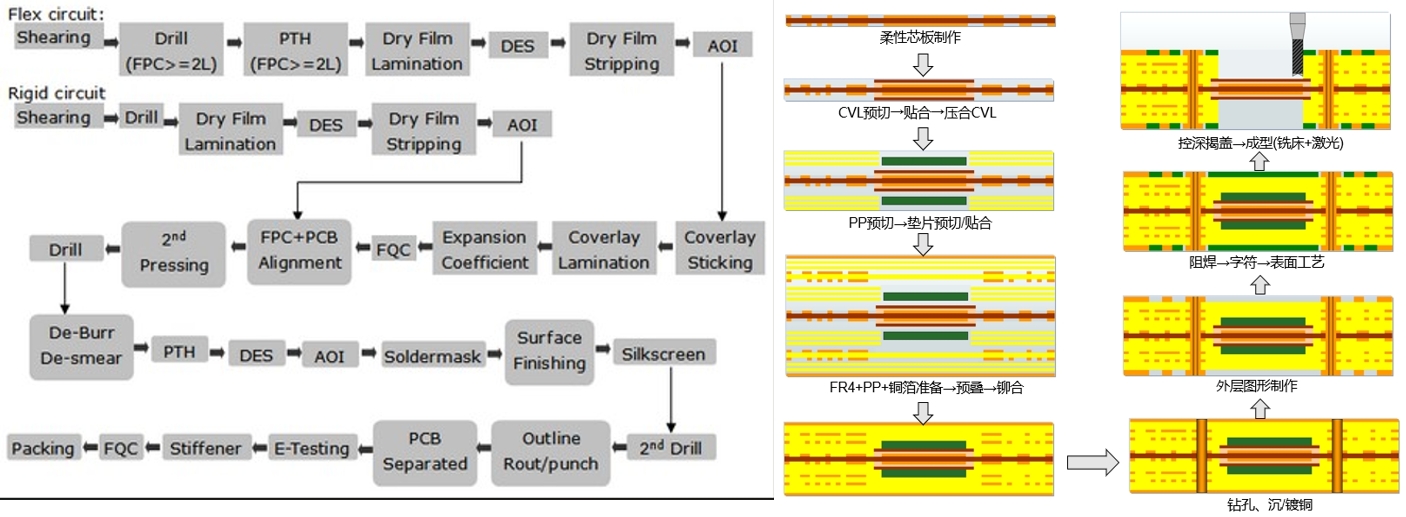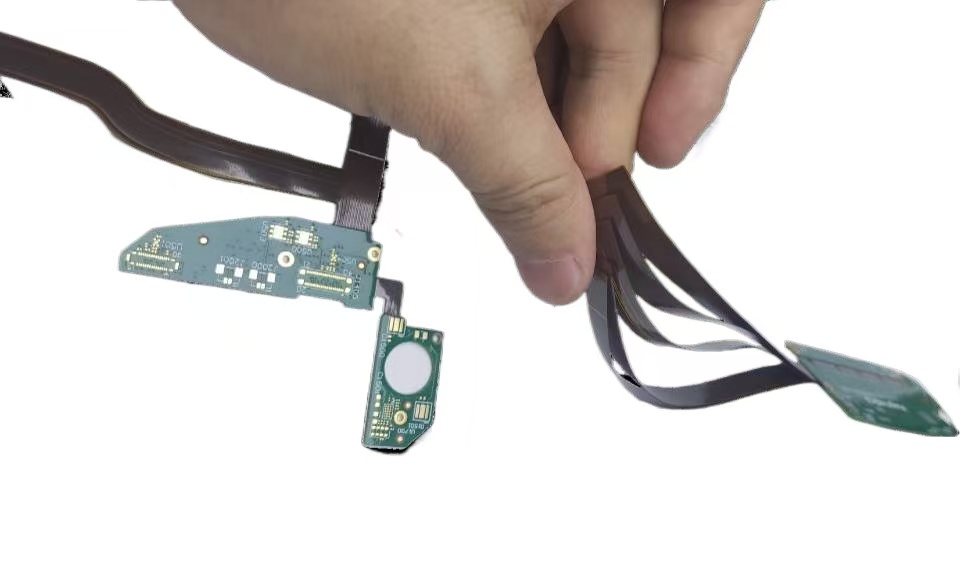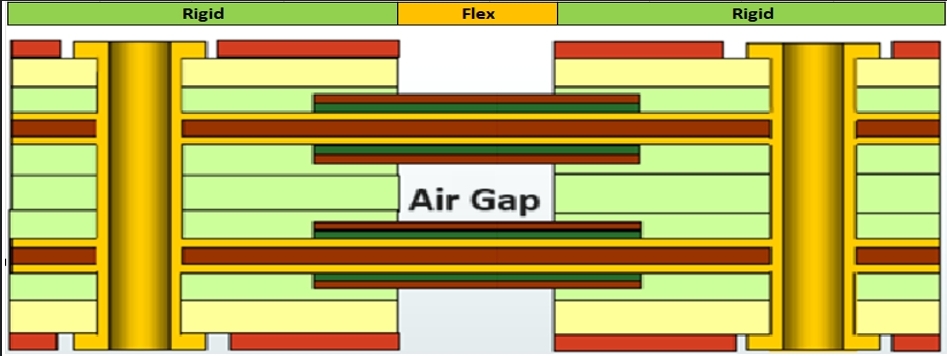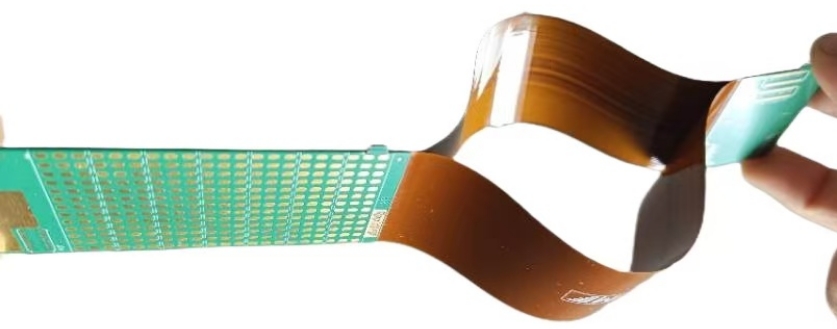Air Gap Flex-Rigid PCB are An Innovative
Air Gap Flex PCBs are an innovative and specialized type of printed circuit board, setting themselves apart from traditional designs. An air gap, as the name implies, is a space or void between different layers of the flexible PCB. This distinct feature provides several unique advantages.
In the construction of Air Gap Flex PCBs, the air gap acts as a natural insulator. Made with flexible materials like polyimide, which is highly resistant to heat and mechanical stress, the layers are separated by this air gap. This insulation property helps in preventing unwanted electrical interference between adjacent layers. When signals travel through the traces on different layers, the air gap significantly reduces crosstalk, ensuring that each signal remains clear and undisturbed.
The flexibility of these PCBs is further enhanced by the air gap. The air - filled space allows the board to bend and flex more freely without the risk of short - circuits or damage to the internal traces. This makes them ideal for applications where the PCB needs to be frequently bent or twisted, such as in wearable electronics, where the device must conform to the shape of the human body.
Moreover, the air gap can also improve the thermal performance of the PCB. In electronic devices, heat is a common by - product, and effective heat dissipation is crucial for the device's long - term reliability. The air gap acts as a heat buffer, allowing heat to dissipate more evenly across the board. This is especially beneficial in high - power applications where excessive heat can cause components to malfunction.
The design flexibility offered by Air Gap Flex PCBs is another major advantage. The air gap enables a more complex layout of components and traces. Manufacturers can place components in a more strategic manner, taking full advantage of the available space on the board. This results in a higher component density, which is essential for creating compact and powerful electronic devices.
Due to these remarkable features, Air Gap Flex PCBs are in high demand in various industries. In the automotive sector, they are used in in - car infotainment systems and advanced driver - assistance systems, where the need for flexible, reliable, and interference - free PCBs is crucial. In the consumer electronics industry, they find applications in foldable smartphones and tablets, providing the necessary flexibility and performance for these cutting - edge devices.
Vantage of HDI Rigid-Flex PCB
Enhanced Component Density:
In HDI Rigid - Flex PCBs, the combination of blind and buried vias allows for a substantial increase in component density. Blind vias, which connect outer layers to inner - layers without traversing the entire board, and buried vias, linking inner - layer to inner - layer, enable a more compact and efficient circuit layout. This means that more components can be packed into a smaller space, making it ideal for applications where size is a crucial factor, such as in portable electronics like smartwatches and compact medical devices.
Superior Signal Integrity:
These vias play a vital role in improving signal integrity. By reducing the length of signal traces and minimizing the chances of signal interference and crosstalk, HDI Rigid - Flex PCBs ensure that signals are transmitted accurately and efficiently. This makes them highly suitable for high - speed data transmission applications, such as in 5G communication devices and high - performance computing systems.
Greater Design Flexibility:
The flexible sections of HDI Rigid - Flex PCBs, along with the advanced via technology, offer greater design flexibility. Designers can create more complex and customized circuit layouts to meet the specific requirements of different products. Whether it's a product with a unique form factor or one that needs to accommodate multiple functions in a limited space, HDI Rigid - Flex PCBs can be tailored accordingly.
Weight and Size Reduction:
Thanks to the high - density interconnect technology and the ability to integrate more components in a smaller area, HDI Rigid - Flex PCBs contribute to significant weight and size reduction in the final products. This is especially beneficial in applications where portability and space - saving are essential, like in aerospace and mobile devices.
Reliability and Durability:
Despite the complexity of the design, HDI Rigid - Flex PCBs are highly reliable and durable. The use of high - quality materials and advanced manufacturing techniques ensures that the blind and buried vias maintain their integrity even under harsh environmental conditions, such as temperature variations and mechanical stress. This makes them suitable for a wide range of applications, from industrial equipment to automotive electronics.
Advanced Features Incorporation:
Similar to traditional rigid - flex PCBs, HDI Rigid - Flex PCBs can also incorporate features like controlled impedance, EMI shielding, panelization, and circuit assembly (SMT). These additional features further enhance the performance and functionality of the PCBs, making them a versatile choice for various high - tech applications.
Rigid-Flex PCB Capability
As a professional manufacturer of rigid flexible circuit board in China, We always try to improve our capability to produce more rigid-flex circuit board to our customers. Here is major capability:
- 1-10 flexible layers; multiple flex layers in either bonded or air gap configuration
- 1-40 rigid layers
- 2-50 layer rigid flexible circuits
- Flex Core Materials: Polyimide (PI): 1/2 mil to 4 mils in either adhesive or adhesives constructions
- Copper thickness: 1/3 OZ – 2 OZ RA or ED type (insert material/copper-foil.htm) in flexible circuit; 1/2OZ to 10 OZ in rigid circuits;
- Coverlays: 1/2 mil to 2 mils polyimide
- Stiffeners material: polyimide, FR4, stainless steel, aluminum
- Rigid Materials: 130, 170, 180 TG FR4, low flow prepreg
- EMI/RF shielding films
- Blind and buried vias available
- Any layer available
- Controlled impedance: 50 ohm, 90 Ohm, 100 Ohm, 110 Ohm and other value
- Surface finishing: ENIG, ENEPIG, gold plating, gold fingers (3-30u” Au), Immersion silver
- IPC 6013 – Class II & Class III available
Rigid-Flex PCB Manufacturing Process:
Manufacturing of rigid-flex PCB is much more complicated than other types of flexible circuit, here are simple manufacturing steps for your reference:

I-Tech provides various sizes of rigid flexible Circuit boards, of different layers. All Rigid-Flex Circuits are tested with electronic testing reflecting all Gerber data to ensure continuity and other data requirements.
We can provide fast prototypes within 3-7 days, on-time delivery, great quality for you. Please contact us today for more information about rigid flexible circuits.




